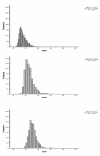Relationship between 8/9-yr-old school children BMI, parents' BMI and educational level: a cross sectional survey
- PMID: 21771312
- PMCID: PMC3160354
- DOI: 10.1186/1475-2891-10-76
Relationship between 8/9-yr-old school children BMI, parents' BMI and educational level: a cross sectional survey
Abstract
Background: Parents are responsible not only for the genetic structure of their children, but also for passing onto them their behaviours and attitudes toward life. The aim of this study was to analyse the connection between school-age children's obesity and that of their parents as well as between child obesity and parents' educational level, as a proxy indicator of the socio-economic status (SES) of families in Tuscany.
Methods: The children sample was selected from "OKkio alla Salute 2010" (a cross sectional survey carried out by the Italian Institute of Health) and consisted of 1,751 (922 males and 855 females) 8-9 year-old school children. Weight and height were measured by ad hoc trained personnel, and Body Mass Index (BMI) categories were calculated using Cole et al.'s cut-off. Parents' weight, height and educational level were collected by a self-administered questionnaire. The educational levels were classified as high, medium and low.
Results: The prevalence of obese children increased along the parents' BMI category: from 1.4% for underweight mothers to 30.3% for obese mothers and from 4% for under-normal-weight fathers to 23.9% for obese fathers (p < 0.001). An inverse relationship was observed between the parents' educational level and child obesity, the lowest educational level corresponding to the highest prevalence of obese children: 9.3% for mothers with a low educational level compared to 5.8% for mothers with a high educational level (p = 0.15); similarly, the corresponding prevalence for fathers was 9.5% compared to 4.5% (p = 0.03).
Conclusion: Parents' obesity and the cultural resources of the family, particularly the father's, seem to influence the prevalence of overweight and obesity in Tuscan children.
Figures
References
-
- Clement K, Vaisse C, Lahlou N, Cabrol S, Pelloux V, Cassuto D, Gourmelen M, Dina C, Chambaz J, Lacorte JM, Basdevant A, Bougneres P, Lebouc Y, Froguel P, Guy-Grand B. A Mutation in the human leptin receptor gene causes obesity and pituitary dysfunction. Nature. 1998;392:398–401. doi: 10.1038/32911. - DOI - PubMed
-
- Montague CT, Farooqi IS, Whitehead JP, Soos MA, Rau H, Wareham NJ, Sewter CP, Digby JE, Mohammed SN, Hurst JA, Cheetham CH, Earley AR, Barnett AH, Prins JB, O'Rahilly S. Congenital leptin deficiency is associated with severe early-onset obesity in humans. Nature. 1997;387:903–8. doi: 10.1038/43185. - DOI - PubMed
Publication types
MeSH terms
LinkOut - more resources
Full Text Sources
Medical
Miscellaneous



